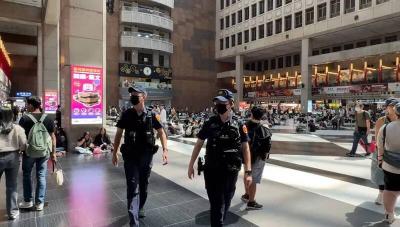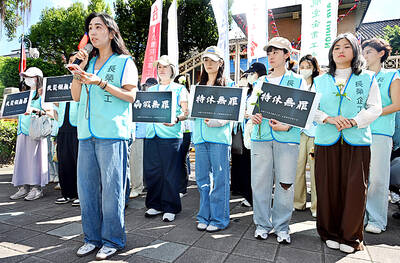Yesterday’s collapse of the Nanfangao Bridge (南方澳橋) in Yilan County might have been due to rusted anchoring points, Taipei Technology College of Engineering dean Sung Yu-chi (宋裕祺) said.
Video footage showed that the vertical cable at the center of the bridge’s steel arch was the first to snap, Sung said.
However, the bridge is suspended by 10 or more steel cables and theoretically, the other cables should have been capable of evenly distributing the weight the broken cable had borne, he said.

Photo: Peter Lo, Taipei Times
However, it looks like the snapping of the vertical cable caused a domino effect, Sung said.
The bridge was continuously exposed to salty air, which would have rusted the cables, reducing the amount of weight the span could support, Sung said.
Long-term exposure to wind could have also loosened the anchor points, making them unable to sustain the bridge’s weight, he said.
The collapse of the arch was caused by the dissolution of the force equilibrium between the bridge and the arch, although an investigation is needed to confirm the cause, he said.
Bridges are designed with safety factors and mechanisms taken into account, and routine inspections and precise equipment calibrations are required to maintain normal operations, he said.
Wang Chung-yu (王仲宇), a professor of civil engineering at National Central University, also said the cables could have rusted.
Strong winds brought by Typhoon Mitag would have caused the cables to sway constantly, which could have forced the cables to the point of snapping, Wang said.
An site inspection to determine which anchor point broke first is required, he said.
Authorities should make precise records of the site to compare with the records of the bridge’s last inspection, which could help clarify what happened, Wang said.
The bridge was an older design, created when the idea of protection from natural erosion was not yet popular, and it was possible that maintenance checks could have overlooked such possibilities, he added.
However, he believes that Mitag should be blamed for the collapse.
Taiwan International Ports Corp (TIPC) said it has conducted routine annual maintenance since the bridge was completed 21 years ago and, per regulations, each cable cord was inspected every four years.
The last inspection was conducted in 2016, when the Yilan County Government awarded the commission to Chien Hsin University of Technology and Science, TIPC said.
The university’s report suggested reinforcing the bridge body with concrete, removing rust from the cable beams, repairing the downspouts and replacing the expansion joints of the angle iron, it said.
It budgeted NT$10 million (US$322,113 at the current exchange rate) between 2017 and last year to cover the repairs and reinforcements noted in the report, the company said.
TIPC chief executive Chen Shao-liang (陳邵良) declined to comment on whether the cables snapped first, saying only that the company would await the results of the investigations.
Additional reporting by Hsiao Yu-hsin

A drunk woman was sexually assaulted inside a crowded concourse of Taipei Railway Station on Thursday last week before a foreign tourist notified police, leading to calls for better education on bystander intervention and review of security infrastructure. The man, surnamed Chiu (邱), was taken into custody on charges of sexual assault, taking advantage of the woman’s condition and public indecency. Police discovered that Chiu was a fugitive with prior convictions for vehicle theft. He has been taken into custody and is to complete his unserved six-month sentence, police said. On Thursday last week, Chiu was seen wearing a white

EVA Airways, one of the leading international carriers in Taiwan, yesterday said that it was investigating reports that a cabin crew manager had ignored the condition of a sick flight attendant, who died on Saturday. The airline made the statement in response to a post circulating on social media that said that the flight attendant on an outbound flight was feeling sick and notified the cabin crew manager. Although the flight attendant grew increasingly ill on the return flight, the manager did not contact Medlink — a system that connects the aircraft to doctors on the ground for treatment advice during medical

The Taoyuan Flight Attendants’ Union yesterday vowed to protest at the EVA Air Marathon on Sunday next week should EVA Airway Corp’s management continue to ignore the union’s petition to change rules on employees’ leave of absence system, after a flight attendant reportedly died after working on a long-haul flight while ill. The case has generated public discussion over whether taking personal or sick leave should affect a worker’s performance review. Several union members yesterday protested at the Legislative Yuan, holding white flowers and placards, while shouting: “Life is priceless; requesting leave is not a crime.” “The union is scheduled to meet with

‘UNITED FRONT’ RHETORIC: China’s TAO also plans to hold weekly, instead of biweekly, news conferences because it wants to control the cross-strait discourse, an expert said China’s plan to expand its single-entry visa-on-arrival service to Taiwanese would be of limited interest to Taiwanese and is a feeble attempt by Chinese administrators to demonstrate that they are doing something, the Mainland Affairs Council said yesterday. China’s Taiwan Affairs Office (TAO) spokesman Chen Binhua (陳斌華) said the program aims to facilitate travel to China for Taiwanese compatriots, regardless of whether they are arriving via direct flights or are entering mainland China through Hong Kong, Macau or other countries, and they would be able to apply for a single-entry visa-on-arrival at all eligible entry points in China. The policy aims